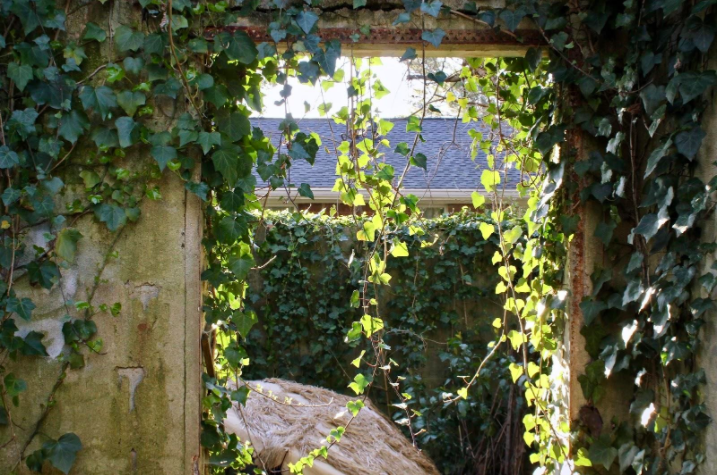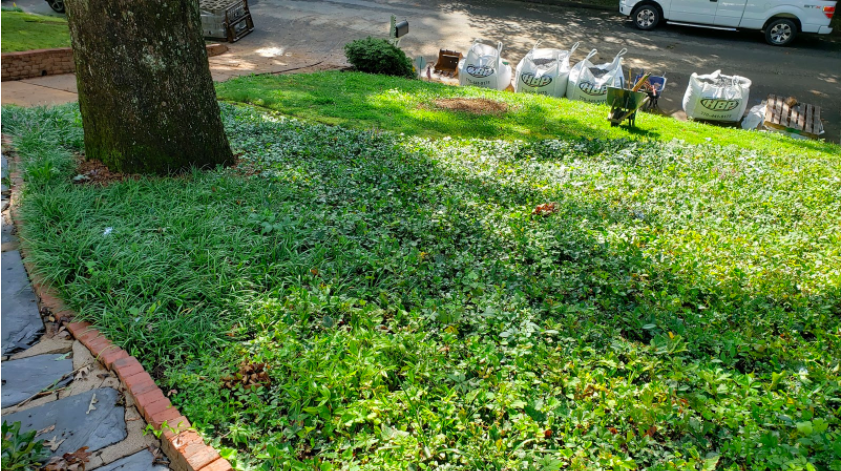The following post is a contribution from staff member Heather Lacy.
The sun is setting in Kirkwood Urban Forest, and the leaves encapsulating an old abandoned building shine bright green and gold-tinted. The ground underfoot is hardly visible in some places, a foliage carpet made of pointed leaves and quickly creeping vines hiding the rich brown of the soil underneath. Climbing vines cling to nearby trees’ varied trunks, some missing sections at chest high, evidence of a recent removal attempt.

Many know this plant by the name “English Ivy.” Brought to North America as an ornamental plant by European colonizers, English Ivy quickly escaped and spread prolifically in its new habitat. Considered by many to be an “invasive” weed (again, we put “invasive” in quotes because there is a lot to unpack there), English Ivy is the recipient of much-warranted criticism. Still, as is usually the case, such a one-sided view doesn’t do justice to the picture’s entirety.
A weed is defined as “a wild plant growing where it is not wanted and in competition with cultivated plants.” Plants that are considered weeds are often thought of as nuisances, stubborn, and even problematic, and English Ivy certainly fits the bill in a variety of ways, including but not limited to, the following:
- English Ivy is often in competition with native species, creating a dense foliage carpet that decreases germination and growth rates of seedlings, native groundcover, perennials, and understory plants.
- English Ivy’s evergreen status allows it to increase in winter. With the canopy more open due to winter leaf loss, English Ivy can overtake host trees, inhibiting growth and potentially creating instability.
- The extreme density of the foliage provides inadequate habitat for a majority of native wildlife.
- Mosquitos, notably the Asian tiger mosquito (Aedes albopictus) that we have here in Atlanta, use English Ivy as their preferred breeding ground.
Many of our most common weeds, even those labeled dangerously “invasive,” are filling a niche to the best of their ability and offer some ecological contribution in exchange for their presence. Even a plant as prolific and vilified as English Ivy is capable of duality, being of benefit in the following ways:
- Erosion control

Established English Ivy and other ground cover plants help to stabilize a steep hillside at a recent job site
- Improved air quality: studies show English Ivy to be a “particle sink,” absorbing fine and ultrafine particles, especially in high-traffic areas with abundant automobile exhaust.
- Topsoil builder: English Ivy has an affinity for trapping organic matter, including branches, leaves, and dead animals, below its dense foliage, where they then decompose. Rich topsoil beneath her carpet can be observed upon removal.

When profiling our common weeds, it is essential to remember that plants considered to be “invasive,” such as English Ivy, are often encouraged by human activity. From ornamental plantings to climate change, pollution, and deforestation that alter ecosystems, the root causes of English Ivy expansion stretch far beyond the oversimplified narrative of an overzealous opportunist decimating native species.
Taking a closer look at what we call weeds begs the question of why we do so. And searching beyond the label of “weed” to discover each plant’s multidimensional existence in our surrounding ecosystem gives us a better understanding of how to work like, with, and for nature to help restore and support our beloved earth and it’s sustained biodiversity. When a plant aggressively takes over an area, that is an indicator of ecological imbalance and lack of predation.
NOTE: It is necessary to be mindful of the ecological impacts of the plants that surround us. When possible, it is preferred that English Ivy be replaced with an alternate plant, particularly one of native status, and although it can still be bought at nurseries in some places, new stands should not be developed.
In a previous post about Permaculture and Native Plants, we briefly discussed instances where we might use non-native species in permaculture landscapes.